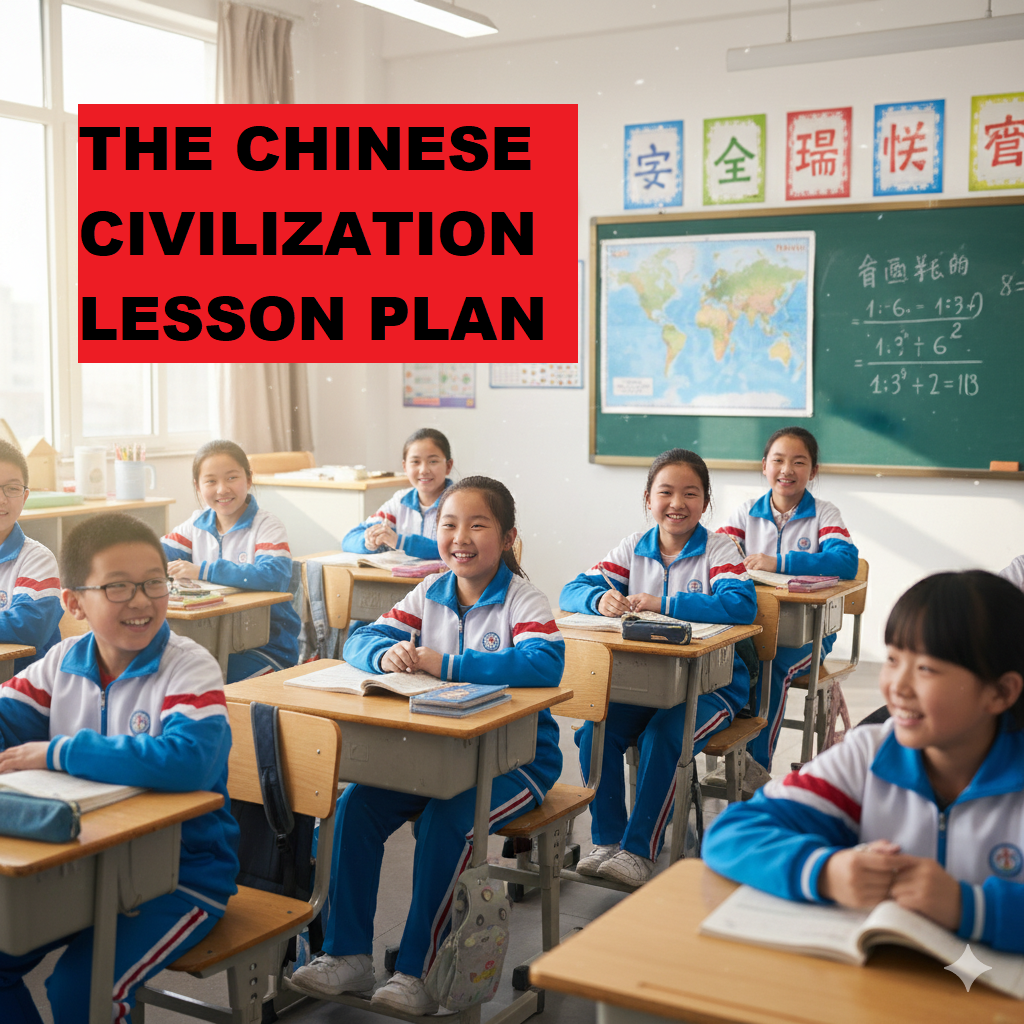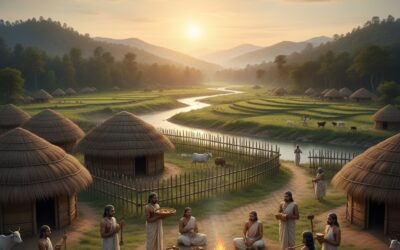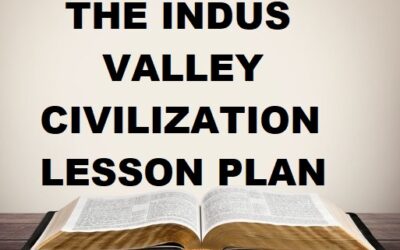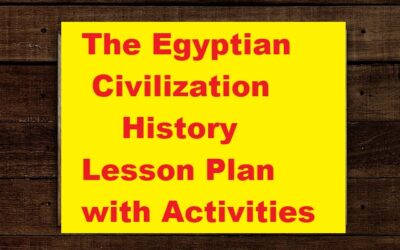The Chinese Civilization – History Lesson Plan with Activities
The Chinese Civilization Lesson Plan provides educators with a solid and interesting means of introducing one of the globe’s oldest and most significant civilizations. This Chinese Civilization Lesson Plan assists teachers in transcending the textbook approach by integrating imagery, activities, and discussions that make history come alive.
Furthermore, it enables students to grasp how geography, culture, innovations, and philosophies impacted historical China and the contemporary world. With this lesson plan, educators can seamlessly take students to discover subjects such as the Great Wall, Confucian doctrine, and ancient innovations such as paper and the compass.
In addition, it fosters critical thinking and cultural enrichment, making history informative and captivating. The Chinese Civilization Lesson Plan is significant in the sense that it redefines conventional learning as a dynamic experience, allowing the students to relate past values to contemporary lessons in innovation, discipline, and harmony.
The Chinese Civilization – History Lesson Plan with Activities
Subject: History & Civics
Class: VI
Chapter: 4 – The Chinese Civilization
Board: ICSE
Duration: 45–50 minutes
1. General Information
Teacher’s Name: __________________________
Subject: History
Topic: The Chinese Civilization
Class: VI (ICSE)
Time Duration: 45–50 minutes
Teaching Method: Explanation, Discussion, Question–Answer, and Activity-Based Learning
Teaching Aids: Textbook, Map of Ancient China, Flashcards, Pictures of the Great Wall, Chinese Inventions, Smartboard/PPT (optional), Timeline Chart
2. Learning Objectives
By the end of the lesson, students will be able to:
Identify the geographical location and major rivers of ancient China, particularly the Huang He (Yellow River).
Describe the political, social, and religious life of the people of ancient China.
Identify the significant inventions and accomplishments of Chinese civilization.
Describe the contribution of Chinese dynasties to world culture and knowledge.
Understand the values of discipline, innovation, and harmony in Chinese life.
3. Introduction of the Topic (Engagement – 5 minutes)
Start the class by displaying a photo of the Great Wall of China and ask:
“Have you ever wondered why this wall was constructed and how old it is?”
Briefly discuss that the Chinese civilization is one of the oldest in the world, thriving along the Huang He (Yellow River), commonly referred to as “China’s Sorrow” because of regular flooding.
Introduce the subject:
???? “Today, we will learn about The Chinese Civilization — its people, rulers, inventions, and how it contributed to world history.”
“From Books to Backstage: Creative Theatre Scripts for Class VI History”
4. Teaching Aids
Visual Aids: Charts and images of the Great Wall, Chinese writing, and early dynasties.
Maps: Map of ancient China with the Huang He and Yangtze Rivers.
Audio-Visual: Brief video clip or slide presentation on ancient China (optional).
Models/Props: Chinese coins, paper, compass models, or calligraphy specimens.
Board Work: Key terms like Huang He, Dynasties, Inventions, Confucius
5. Teaching Procedure
Step 1: Explanation (15 minutes)
A. Location and Growth of Civilization
Ancient Chinese civilization developed along the River Huang He.
Fertile plains nourished agriculture, particularly rice and millet cultivation.
B. Political Life
Early dynasties were Shang, Zhou, and Qin.
Emperors governed with the assistance of officials and warriors; they were “Sons of Heaven.”
The Great Wall of China constructed to safeguard the empire from invasion.
Community-Based Instruction: “Empowering Students Through Real-World Learning”
C. Social and Religious Life
Society was stratified: Emperor → Nobles → Scholars → Farmers → Artisans → Merchants.
Nature gods and ancestor worship were prevalent.
Confucius, a great teacher, educated on moral values and respect for elders.
D. Inventions and Achievements
Paper, compass, silk weaving, porcelain, and gunpowder were significant Chinese inventions.
They created calligraphy, architecture, and trade routes like the Silk Road.
E. Decline
Gradual decline was due to wars, invasions, and internal conflicts but the culture remained strong.
Step 2: Discussion (10 minutes)
Ask questions to test understanding and generate thinking:
“Why is the Huang He River known as the cradle of Chinese civilization?”
“How did Chinese inventions revolutionize the world?”
“What moral lessons can we derive from Confucius’s teachings?”
Ask students to give their answers and discuss the significance of Chinese contributions.
6. Activity 1 (Group Work – 10 minutes)
Title: Timeline of Chinese Dynasties
Split the class into small groups.
Each group creates a timeline chart with the Shang, Zhou, Qin, and Han dynasties and one significant achievement for each.
Groups briefly display their charts in class.
7. Activity 2 (Individual Work – 10 minutes)
Title: Ancient Chinese Invention Poster
One invention is chosen by each student (e.g., paper, compass, gunpowder, silk).
They paste or draw a picture and write a few sentences about its purpose and significance.
Put up the posters on the class bulletin board.
क्यों अफ्रीका को कहा जाता है DARK CONTINENT ?
8. Classwork
Short Answer Questions:
What river is referred to as the cradle of Chinese civilization?
Mention any two of the most renowned Chinese inventions.
Who was Confucius?
Why was the Great Wall of China constructed?
Map Work:
Mark and identify the Huang He and Yangtze Rivers on a map of China.
9. Homework
Compose 8–10 lines of “The Contributions of Ancient China to the Modern World.”
Sketch a clean diagram or drawing of the Great Wall of China and mark it.
Study key words: Dynasty, Confucius, Silk Route, Calligraphy, Invention.
10. Learning Outcomes
Upon finishing this lesson, students will be able to:
Identify ancient China and its largest rivers on a map.
Describe the political, social, and religious organization of the Chinese civilization.
List significant Chinese inventions and their global influence.
Outline the teachings of Confucius and how they apply today.
Value the discipline, creativity, and cultural diversity of ancient China.
11. Remedial Measures
For students requiring extra help:
Re-explain challenging words (e.g., dynasty, Confucius) in simpler terms and with pictures.
Offer summary notes or mind maps for revision.
Facilitate a pictorial quiz with flashcards on inventions and dynasties.
Employ peer tutoring — enable advanced students to assist their peers.
Consolidate learning through a brief summary video or narrative session on “Life in Ancient China.”
Was the Dark Age in Europe Really Dark? Uncovering the Truth About Medieval Europe
The Chinese Civilization – History Lesson Plan with Activities
Conclusion:
The Chinese Civilization Lesson Plan is a great resource for instructors to help students see history in a more substantial and relatable way. This Chinese Civilization Lesson Plan not only clarifies ancient China’s political, social, and cultural life but also helps students see its enduring contributions to the contemporary world.
Additionally, it challenges the learners to consider critically how inventions, philosophies, and traditions have influenced the course of human history. With the incorporation of visuals, debates, and creative exercises, the Chinese Civilization Lesson Plan converts learning in the classroom to an engaging and interactive experience.
In addition, it enables educators to link age-old wisdom with contemporary virtues such as discipline, innovation, and respect. Thus, this lesson plan is a key tool for promoting curiosity and in-depth understanding among students.
How do you believe the Chinese Civilization Lesson Plan can engage your students in appreciating history and culture more intensely?
Role of Disaster Management in Developing an Effective Emergency Recovery Plan
Green Roofing and Cool Roofing Solutions for Urban Heat Island in Metro Cities





0 Comments